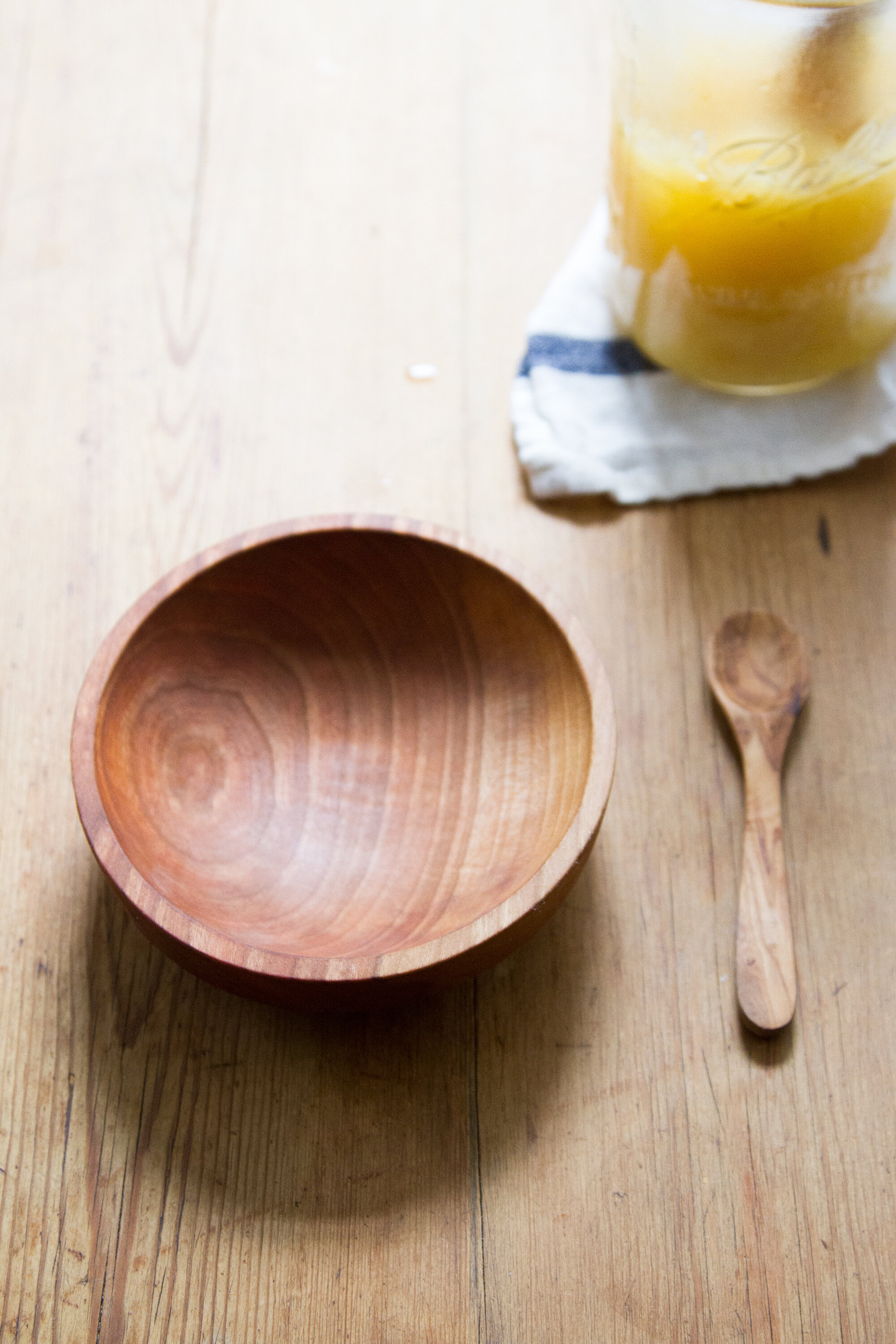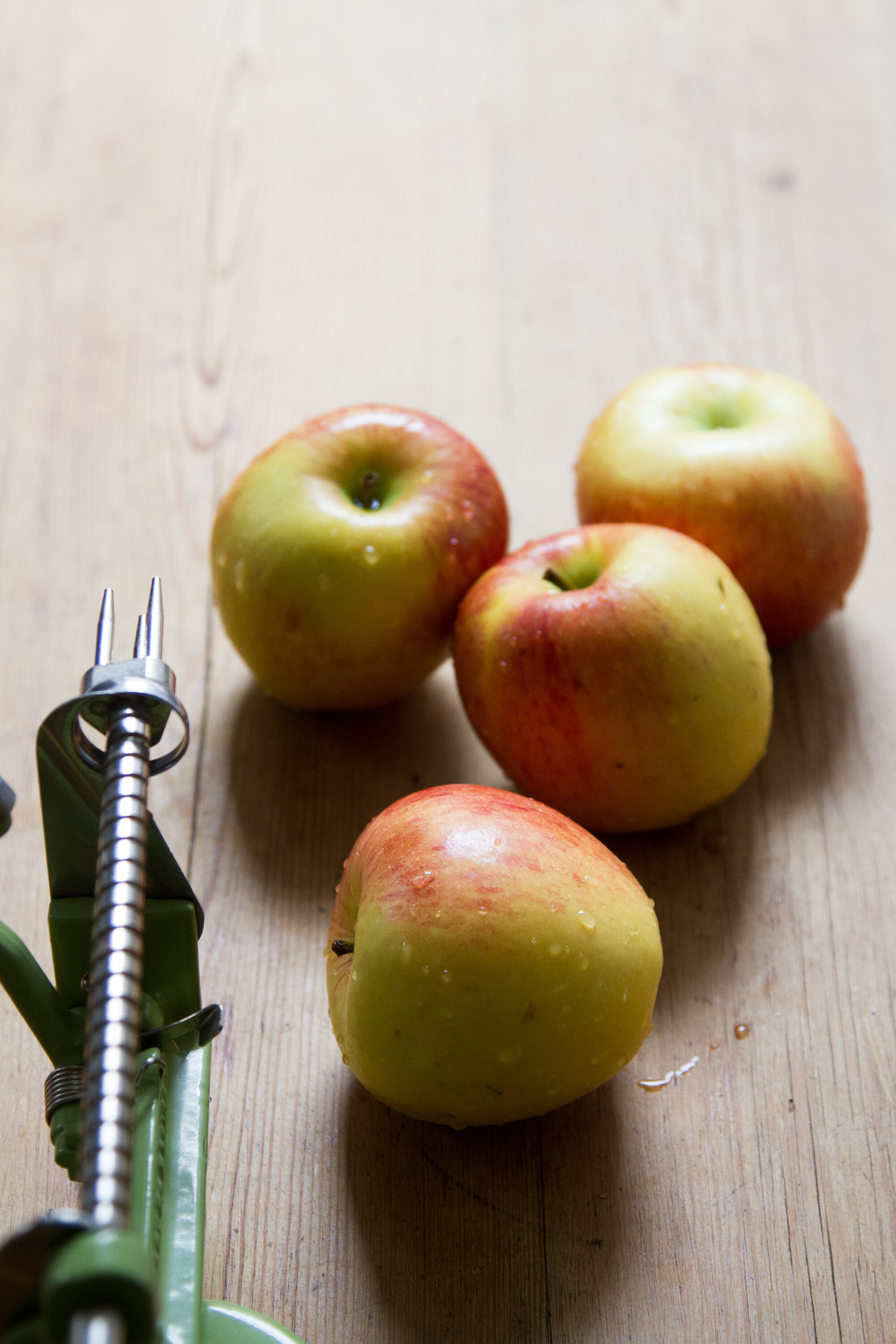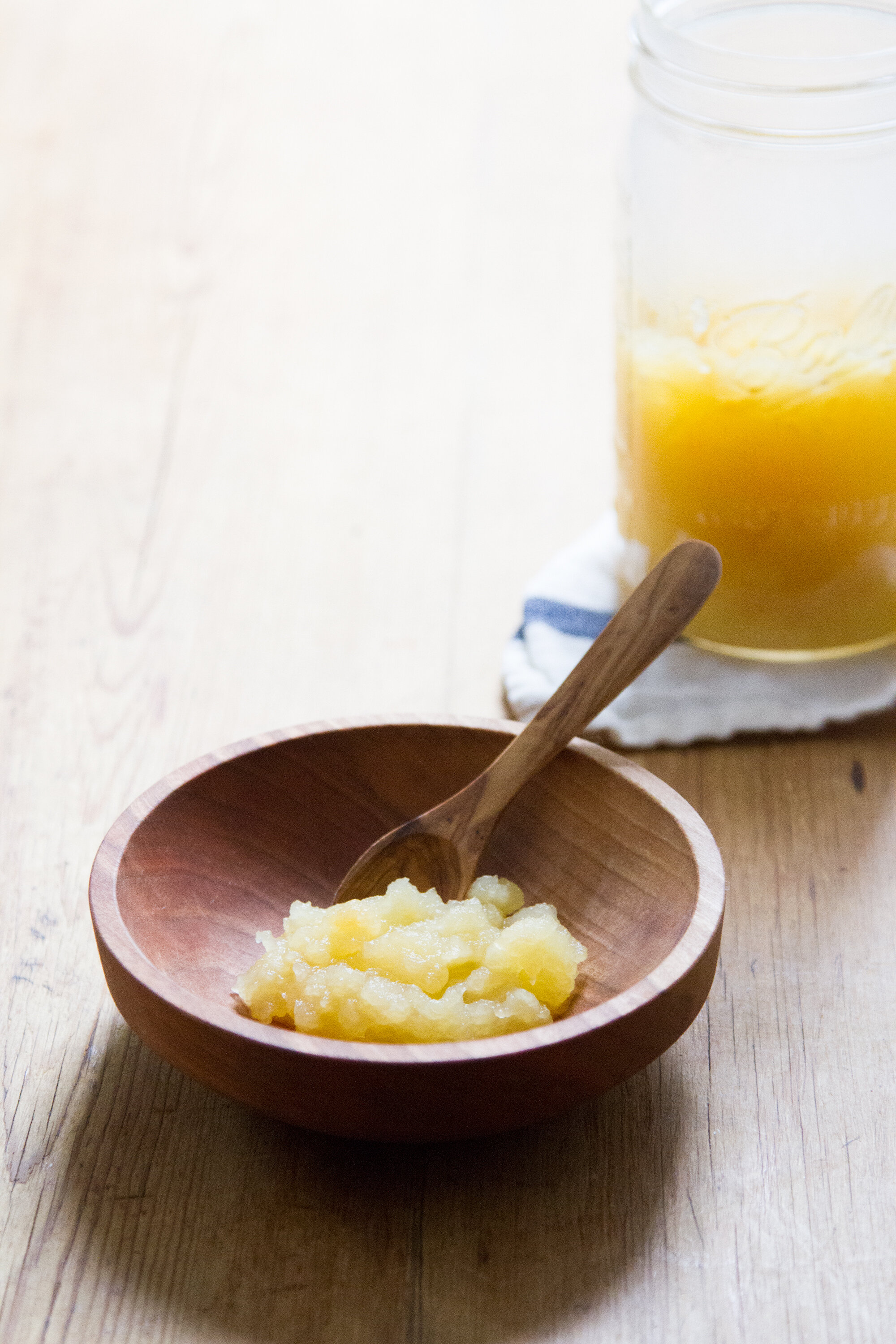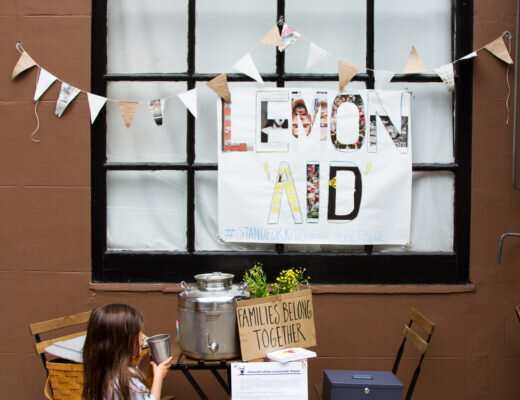 The air is getting cooler, which means that tomatoes are still at the farmers’ market, but instead of cozying up next to ears of corn, they’re sidled up next to apples which are crisp and red and ready for snacking. It’s the season for making a big batch of applesauce and setting it to cool on the countertop.
The air is getting cooler, which means that tomatoes are still at the farmers’ market, but instead of cozying up next to ears of corn, they’re sidled up next to apples which are crisp and red and ready for snacking. It’s the season for making a big batch of applesauce and setting it to cool on the countertop.
I’m sometimes asked what I feed my kids as they begin to branch out from their milk-only diet. I wrote a bit about it in my book, but I thought it might be nice to revisit here, especially because it’s applesauce season and especially because at nearly eight-months-old, Silas is determined to eat every single thing in sight.
As with so much else related to growing humans from babies into kids, there’s a lot that gets overly complicated in the world of starting solids. There are gadgets and gizmos and other products for sale that would leave you wondering if you need to invest a small fortune into turning your kitchen into a baby food factory. There are blog posts aplenty that might have you thinking you need to set up permanent shop in the kitchen, pureeing perfectly balanced morsels fit for tiny palates. There are pre-made foods on the market that might make you feel that your child must get a simultaneous taste of kale and peas and mangos and sweet potatoes every time they take a swallow…or else. And then there are books with theories on baby feeding that might make you feel like you’re doing permanent damage by introducing a spoon to your baby in the first place. A lot of it feels like it’s preying on a general parental anxiety that we’re not doing it right or haven’t sacrificed enough.
Screw it.
I’m hardly an expert, but in our family we’ve introduced solids in a few different, mostly very low-impact, ways. (Low-impact for the parents, that is.) Because it’s easy and because it produces nearly no extra waste, we’ve mostly always fed our kids what we’re eating ourselves. We’ve spoon-fed our babies when the food we had at hand fit neatly onto a spoon and semi-neatly into a mouth. We’ve let them maul their own soft foods when that seemed to make more sense and when we’ve had a whole morning ahead of us to remove banana plaster from hair and furniture. Other times, we’ve made applesauce because it’s the season to embrace apples and because the nights are coming faster and time spent indoors is increasing and because stewing fruits with a stick of cinnamon is a nice way to conjure a bit of autumnal magic. (And yes, we’ve bought jars of it when we’ve been too busy for witchy merry making.)
In our house, soft foods like bananas and oatmeal and avocados and tofu get mushed in a cup at the table. Beans might get cooked a bit longer and smushed for hungry, gummy, mouths. Tiny cups of kefir get poured and usually drunk, but also sometimes dashed to the floor in messy puddles. I do my best to make sure that I’m not giving babies anything they can choke on, but I’m also pretty confident in the baby gag reflex and so I let them explore with holding things like strips of sweet pepper or cucumber or whatever else they can gum to death and learn to appreciate over time. Solids, simply.
//
Whether or not there’s a baby that wants a nibble, a pot of homemade applesauce is a nice thing to make on a cool day. I peeled my apples, because goodness knows I need to put our apple peeler to work sometimes and because I don’t have a food mill. I didn’t add sugar, because babies and apples are two things that don’t really need sweetening. Below is the general gist.
Homemade Applesauce
Makes about a quart, depending on the size of the apples
What you need:
4-5 apples (a mix of varieties is nice, but I used Braeburns here)
a pinch of salt
water
What to do:
+ Peel and core your apples and slice them into uniform pieces.
+ Place apples in a heavy-bottomed sauce pan with about 1/2 inch of water in the bottom and a pinch of salt.
+ Cover and bring water to a boil. Once boiling, uncover and reduce heat slightly. Let cook until apple slices are soft and falling apart, about 30 minutes. Stir occasionally to make sure they’re not sticking or burning.
+ Smash apples with a wooden spoon and refrigerate.
For the curious:
Our wooden baby bowl and spoon.
Our apple peeler/corer.
And for my curiosity:
Any favorite things to serve hungry baby birds, er, humans?




26 Comments
Our baby eats what ever we are eating as well. Ours (12m) loves all fruits, legumes, fish and soft vegetables (pumpkin, sweet potatoe, avocado). Since her teeth are killing her these days we’ve chosen cooler products: cucumber, watermelon, melon… eventos gazpacho!
She’s lucky we live in Spain (fresh cheap produce, wide variety of foods)… and so are we!
I don’t have babies yet, but as someone who will likely have babies in the next few years, I really appreciate your perspective. I already read your blog regularly, but know that you are particularly bookmarked when it comes to level-headed parenting!
I feel like I could have written this comment. Same!
I make applesauce too, sans sugar. I have not used the apple tool, but maybe I should learn. I avoid iron pans because, although still tasty, I prefer my applesauce to not turn grey. Live and learn! I recently bought a cherry salad bowl from another American carver that I use to make big salads. Supporting American artists (not local for me since he is in Michigan and I am in Arizona) brings me joy each time I eat big salads. Thank you for showing us where to buy the baby bowl and spoon, a gift for a special someone yet to come from the future.
We have two and one on the way. When my oldest was a few months old, we read “Hungry Monkey,” and were totally inspired by the non-traditional approach that father took to feeding his daughter. It fit more with our “foodie” and “lazy” mentality than anything else. We mostly did what you do, which is serve table foods. The food I cooked changed. I started cooking more soups and other soft dishes that we could share. But we fed our kids everything. The day our oldest turned 6 months, we gave him some brioche from the farmer’s market, and he was hooked on real food. We tried the day our second turned 6 months, but he wasn’t ready. It took until he was 8 months before he could swallow anything but milk. Nevertheless, we always fed the kids table food, believing that giving them sour, spicy, sweet, salty, and definitely not bland foods would help develop their palates. We did not want children who would only eat bland foods. At almost 7 and almost 4, they are two of the most adventurous eaters I know. They eagerly gobble arugula salads and fried okra, spicy Thai noddles, fishy herring or kippers, and endless amounts of ice cream and cake, and all with equal vigor. Studies show that what mama eats when baby is in utero, as well as what we feed our kids in the early solid food eating months makes a difference in what they like later on. I say start introducing every flavor early on. And don’t take no for an answer. If they don’t like the taste of the arugula with lemon juice and olive oil, the next time you serve an arugula salad, dress it in a nice vinaigrette. If they don’t like boiled green beans, roast them instead.
We fed both of our babies (now 4 and 1) what we were eating for the most part and it worked for us. My mother in law still talks about seeing our 7 month old gnawing on a piece of broccoli! Part of our desire to do it this way with our first was that “they” (whoever they are) say that it lends to less picky eaters. Well I am here to say that is definitely not the case. Our amazing eater eventually turned into a toddler and became picky all on her own. We still only give her what we eat but there’s a lot more whining these days. With the second, we did it out of sheer laziness and while he is an amazing eater at 1, I am now fully prepared to have no control over his likes and dislikes as he ages. As for favorites: bananas (really any fruit but bananas especially), tortellini with pesto, pulled pork, broccoli and grilled cheese are current favorites in our house.
I like to see this “pickiness” as really expressing independence. One day our son (who loves tomatoes) will complain that he only likes them raw, or cooked, or whatever the opposite it is that we served. But we have always followed the: you don’t have to like it, but you do have to taste it rule, and we don’t make a big deal otherwise. Often, the younger one will refuse to eat his first course salad (we always serve veggies first!), but when we remind him that the rest of us will be moving on to something better without him unless he tries his salad, he will eat it. It’s all about not making a fuss. Just presenting the food, and letting the kids make the decision as to how much they feel like eating that night (so long as they try a bite!).
We’re taking a similar approach with our almost one year old, and while he was very adventurous with his eating and tried everything we had from about months 8-11, he had recently decided he wants protein, please and thank you, end of story. So lots of scrambled eggs, whole milk yogurt, mozzarella, and ground beef (which my husband is happy to have around again since pregnancy turned me vegetarian).
We’ve also found that trying new textures and combinations has helped a lot. He didn’t want to eat peach slices, but when I puréed a few he couldn’t eat them fast enough. He refused mashed banana, but loves to split a whole one with me. He has always loved roasted root vegetables, particularly carrots and sweet potatoes, and chews on cucumber and zucchini rounds. We used to do a lot of frittatas before he started picking out the vegetables. We also recently tried those two ingredient banana pancakes you see floating around the internet (bananas and eggs whipped together and cooked stovetop) and are planning to try basically the same thing with zucchini and kale.
Lightly steamed broccoli florets! My twins (now 18 months) LOVED this when we first gave it to them around 7 months old. Their little hands fit perfectly around the broccoli stems and they loved to nibble all the little floret bits off the top.
My father-in-law fishes often, and my 20 month old loves eating the fresh fish with a simple tahini and lemon sauce. She also loves beans and rice, lentils and rice, most meats, roasted broccoli, zucchini, sweet potatoes, carrots and peas, and a popular Lebanese jute leaf stew. We live in Lebanon, and right now she can’t get enough peaches and pomegranates. She did go through a very picky phase from 15-17 months that was very difficult for us, but it may have been due to some incoming molars + changing taste buds. If she refuses something, we try not to make a big deal of it, and we reintroduce it again when she’s hungrier.
I stopped pureeing and mashing foods after my daughter had about 4 teeth (now 8 pearly whites). She has no problem with shredded chicken, turkey meatballs from TJ’s, steamed baby carrots, and black beans. But her absolute favorite are whole blueberries grabbed by the fistfuls and stuffed into her mouth.
I used to make hummus for my kids when they were starting to eat solids as well as a pureed cold pea dip. That way, the older ppl can have chips and dip while the baby eats a meal! Thanks for the applesauce recipe. I usually make mine in the slow cooker overnight but I think I’ll give your way a try!
Before I had kids, I read an article in the New Yorker about food allergies that really struck a chord with me. The article said that, in less developed countries, there are far fewer food allergies and that scientists have begun to understand that one of the reasons is that their “baby food” is regular grown-up food that has been pre-chewed by a parent, and then fed to the baby. The pre-chewing actually begins to digest the food (via salivary enzymes) and so is significantly easier for the baby to digest and process. If the baby is allergic, they are being exposed to a gentler, pre-digested version of the allergen, and so the reaction is less severe. Anyway. I thought it sounded neat to avoid food allergies, so I filed it away for future parenting. When my kids were born, I tried it out thinking that I was doing a great thing for their immune system. Then I realized that the pre-chewing thing is so much simpler than any alternatives. I didn’t have to worry about cooking something different for the kids, or chopping it up, or mashing it. I could just chew up a small bite and then (politely, discretely) feed it to them or give it to them to eat. Anything that’s already mushy or soft or easy to gum gets handed over or spooned in, but the bigger, more solid stuff gets chewed first.
I think my family was initially grossed out, but then they saw that a) it’s not that gross, and b) it’s just so easy. My kids are both great eaters, too, so it’s easier to make my case.
Here’s the original article I read, if anyone is interested. https://www.newyorker.com/magazine/2011/02/07/the-peanut-puzzle
We gave traditional foods as first solids to both our children, generally following the recommendations of Nourished Traditions. Favorite foods included soft-boiled egg yolk, mashed vegetables cooked in chicken broth, and fish (all foods that were easy on their gummy mouths). We usually served them versions of what we ate ourselves, rather than relying on commercial baby foods. The food mill was a very valuable kitchen tool for helping to de-seed and mash foods for them.
I was so excited to feed my kid solid food and of course my girl wouldn’t eat much besides cheese and cheerios until she was 13 months old. The eat what we eat approach has been roundly unsuccessful thus far. I just try not to outwardly care that she eats.no.freakin.vegetables and give her the unprocessed foods she does like, keep trying new things over and over and have compromised on cheerios and sneaking puréed veggies into yogurt. I do have to prep cook for her in batches because its hard (and demoralizing) to cook two different meals. Sara Forte of Sprouted Kitchen has a great feeding babies series and Food52 has a green meatballs recipe (no meat) that also got some greens into my girl.
I do think it’s important to point out that we should trust our instincts on the whole.
Recommendations alter all the time as to what is good and right. Just between my eldest and youngest there was a big difference in opinion, over a period of 12 years. Let me say that my three daughters are now grown up and have no food-related problems. The eldest was born at a time when solids started at 2 mths. Our neighbour’s gift to me on her birth was a tiny saucepan and whisk for making baby’s food… The second daughter ate any (cow-)milk product in huge quantities from the age of about 5 mths, milk, yogurt, quark, soft cheese… The last child was gasped at for wanting curried shrimp at 6 mths (she wasn’t in the least bit interested in being breastfed after about 5 mths, like my youngest granddaughter) and the older women gasped when I popped cucumber rings on her thumb for her to suck at. She celebrated her first birthday with Mexican food her older sister refused. Times change, recommendations change, cultures differ – the kids generally get on with it all just fine!! My four grandchildren’s eating habits are as varied as their characters, and yes, there is usually a picky eater phase – one of our daughters, when she was about 7 or 8, was asked by my mother-in-law to write a list of foods she would eat so that appropriate fare could be offered; on the following week’s visit, she refused the offerings and when the list was produced, announced, “but that was last week”. Yeah.
I thoroughly enjoyed weaning my second child as was confident to do it my way and it was so much better! I would be so interested to know what your family meals of the week look like, I am in the process of moving away from using supermarkets but am finding myself quite lost and often overspending, I think it is trying to find a balance between my budget and good food.
I have four kids and they all ate different thing as a first solid food:) My first one had some banana, second one had some sweet potato, third one carrot and fourth one some pear and for all of them I gave only those four things in first three solid food- months. They were good:)
My little one just started on solids, he’s 5 months. He’s a pretty enthusiastic eater, and when he started trying to get other people’s food into his mouth, I thought it was a good time to start solids. Thick purees are his current preferred texture (grabbable pieces end up being mostly played with), and he’s game for what we are eating… mashed up cucumber, squash, sweet potato, carrot, peas, green beans, avocado, fig. banana. I made some tiny jars of apple and pear puree for him while I was doing some other canning and plan to do the same with stone fruits this weekend. Our approach has been pretty laid back, although I did freeze little cubes of puree for days when I won’t feel so prepared.
May I add a short ps? Peas don’t always agree with young children and can make them very gassy…!
I love this post! We’re on the lazy, low fuss route to solids – and it’s fun to hear how your family eats. While I am generally WAY too lazy to read books food, I was gifted “The Pediatrician’s Guide to Feeding Babies and Toddlers”. This is written by our pediatric GI specialist who has helped our kids through terrible reflux, post pyloric stenosis surgery etc, and its really down to earth, has great overall tips, and fantastic recipes for babies, toddlers, and adults (whether or not your kids had stomach issues like ours). If you want some healthy recipes and overall tips on development and eating, this is a great resource.
https://www.amazon.com/Pediatricians-Guide-Feeding-Babies-Toddlers/dp/1607749017
Hello, great post! Me and my wife are expecting a baby in 3 months and we can’t wait, a lot of education awaits us although 🙂 Thanks!
we basically use the same approach to solids: we feed our 9mo what we’re eating that’s appropriate to her and to the occasion (ie, sometimes mama just doesn’t have the patience to clean up the glorious avocado explosion *again,* but we can handle greasy fingers from well-buttered toast strips). she loves black beans, eggs, sweet potatoes, soft stewed meats, zucchini, mushrooms, julienned sweet peppers and cucumbers, and nearly everything else she’s tried. truly soft pears can be halved, cored, and then given to her to gnaw to her heart’s content (we had a scary moment with a pear that wasn’t ripe enough, though, so watch out). frozen strawberries or blueberries can be sliced or quartered and are wonderful for hard teething days.
we try to let her explore on her own as much as possible, a la baby led weaning, but we don’t sweat it if spoon-feeding is better for any particular scenario (i have no interest in letting her finger paint with her yogurt). as much as possible, we try to introduce her to a wide variety of foods and let her determine how much she wants to eat of them, knowing that her real nutrition is still coming from breastmilk and that force-feeding her is a good way to turn her off to food.
finally, we do our applesauce with nothing more than apples, a splash of water, and a sprinkle of cinnamon, usually made with the apples that got lost in the back of the fridge and are too ripe to be enjoyed raw. less waste and more variety for the win.
I have a question for you. We’ve been propping our 6 month old up in her wooden highchair with a small sheepskin rug. She’s now eating more and more solids- and the situation is getting very messy. What did you use after your babes started eating solids to keep them in the highchair without sliding around?
Honestly, we just have had babies that slide around a bit! We’re always sitting at the table together, so we just have to hoist a few times during the meal.
i just love love love this post. wish that i had read it before my 18 month old started solids. i still didnt buy anything fancy b/c of money but still, i love the idea of not complicating solids for babies. thanks for sharing! 🙂
Comments are moderated.